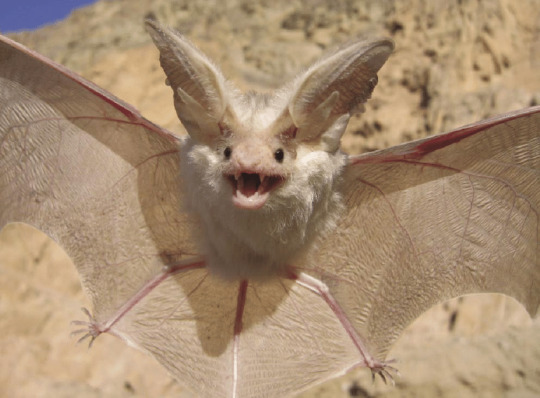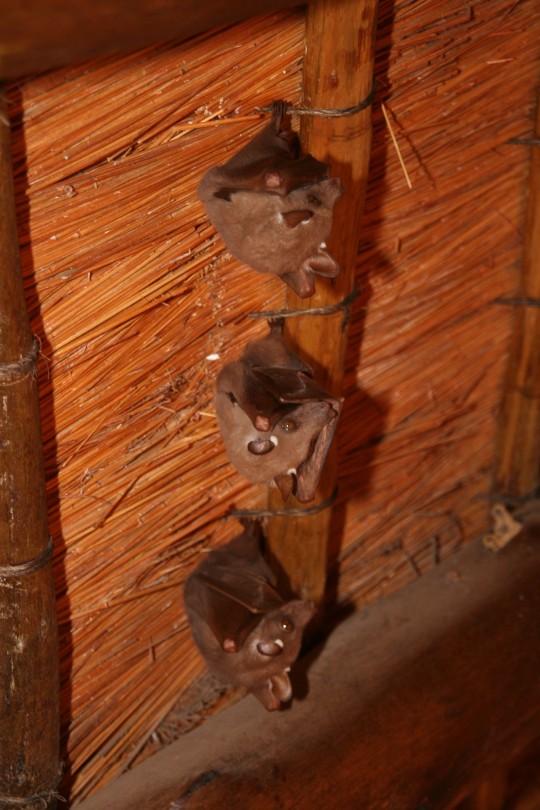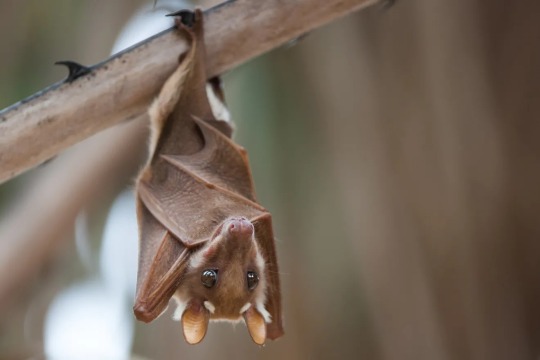#bats of Africa
Explore tagged Tumblr posts
Text

Heart-Nosed Bat, photographed by Simon Musila, (source)
#Heart-Nosed Bat#cardioderma cor#bat#bats#cute bats#daily bats#bats of africa#batposting#chiroptera#false vampire bat#megadermatidae
36 notes
·
View notes
Text
Hands you a Them

#Savi's Pipistrelle#Bats of Africa#bat of the day#daily bat#bat#bats#batposting#cute bats#cute animals#look at them!#LOOK AT THEM
1K notes
·
View notes
Photo

#Rema#HEIS#photography#melanin#black excellence#Africa#nigerian#drip#batman#bat signal#drip check#gold chain#gold#gold jewelry#leather jacket#streetwear#dreads#black mens fashion#black mens hairstyles#photoshoot#aesthetic#dark and moody
239 notes
·
View notes
Text

A Seychelles fruit bat (Pteropus seychellensis) stretches its wings in Mahé, Seychelles
by Gary Faulkner
#seychelles fruit bat#flying foxes#megabats#bats#pteropus seychellensis#pteropus#pteropodidae#chiroptera#mammalia#chordata#wildlife: seychelles#wildlife: africa
1K notes
·
View notes
Text

A fruit bat hangs from a branch in South Africa.
Annick Vanderschelden/Getty Images
#annick vanderschelden#photographer#getty images#fruit bat#bat#animal#mammal#wildlife#south africa#nature
110 notes
·
View notes
Note
Mayst I request chapin's free-tailed bat? :}
Of course! It was a little hard to find good photos, but what a silly looking guy! I wanted to make sure I got a picture in of the male's interesting hair.


The first photo is of a male, and the second is of a female I believe :)
#central africa#southern africa#african wildlife#bat#bats#Chapin's free-tailed bat#insectivorous bats#animal polls#poll blog#my polls#animals#polls#tumblr polls#mammalia#chiroptera
96 notes
·
View notes
Note
Im not gonna lie I genuinely was shocked to see you post a vulture culture post. Not that im not pleased! But of all the blogs I follow, Yours was not a suspect until I saw your name at the top.
it's not a thing I'm into myself but I am adjacent to many people who are into it and I sure can appreciate a good skull
#please make sure your stuff is appropriately sourced though and DO NOT BUY BATS#many bat species in asia and africa that are understudied are being drastically overharvested to make 'bat mummies' and museum specimens
97 notes
·
View notes
Text

Animal of the day: Bat-eared fox! (Otocyon megalotis) The bat-eared fox, also called the motlosi or cape fox, is not a true fox; rather, it is a member of its own genus Otocyon, much like the maned wolves of South America! These small canids are closely related to the raccoon dogs and true foxes! They are actually a basal lineage of canid, which makes them one of the oldest branches of their family tree! In their wild habitat of Africa, bat-eared foxes usually congregate in small family groups, as seen above with a fox and its two kits! Their large ears aid in thermoregulation and allow them to hear their prey rustling through the tall grass with more ease! Image source: https://www.jameswarwick.co.uk/kenya-library/bat-eared-fox-family-nature-wildlife-photography-james-warwick
#fox#foxes#canids#mammals#animals#aotd#animal of the day#weird animals#carnivora#motlosi#otocyon#africa#savanna#bat eared fox#canine
22 notes
·
View notes
Text
Alright, so I was thinking about Hammerheaded Bats (Hypsignathus monstrosa), as one does, and I just... have questions.

Obviously these things are absolutely ludicrous. The deranged-looking eyes, the goblin-esque ears, the lips that look like they got slammed in a car door a few too many times. And, of course, the gloriously fearsome schnozz. As far as creatures go this is one of the creaturey-est. 10/10. Brilliant design.
It gets better, as biology usually does. These bats are large, with a wingspan of almost a meter. Males and females display some rather extreme sexual dimorphism - the males are twice as heavy as the females, and it is only they which possess the extravagant nasal anatomy. That nose is an amplifying chamber, allowing the males to honk at their lady loves with a noise rather like a duck's quack played over a squeaky fence gate. Hammerheaded bats are the only bat species known to mate in a lekking system, in which the males all come together in one place to compete for the females' affections against each other. The males with the loudest, most obnoxious honks are the most desirable to the females.
Hammerheaded bats are one of a very few mammals known to have an XO sex determination system (For reference, humans have an XY system). This means that female bats, like humans, have two X chromosomes, but males do not have a Y-chromosome; instead, they have one X chromosome and that's it. This kind of chromosomal sex-determination is more often seen in insects like grasshoppers.
All of this is good. I love me some weird animals, and Hammerhead bats are no slouches when it comes to weirdness. But, fellas, we've only just scratched the surface when it comes to the weirdness of bat. And I do mean the surface, because the real weirdness is inside.



...
OK so there's a lot to unpack here.
First off, the larynx. It's obscenely large, three times larger in males than in females. It's half the length of the entire spinal column. It's so big that it smooshes all of the internal organs - you know, important things like the heart and lungs - all the way down into the lower abdomen. AND it's connected to air sacs in the throat that amplify the honks even further.
Like. I know why these bats are like this. I know why their honk-producing apparatus is so over-engineered and dominant that there's barely any room for anything else. Biology will do crazy things in pursuit of reproductive success. But like... they still have to live. These are bats. They're endothermic and they fly. Their oxygen consumption is through the roof. HOW do they get away with squishing their heart and lungs that much?! Is there some kind of pocket dimension where the rest of their lungs are stored?! Sir, how do you breathe?!
In conclusion, Hammerhead bats break my brain and I want to know everything about them. I love living on this planet - there's so much bonkers stuff to learn.
Info from https://caitlynfinton.com/2022/05/06/meet-the-hammer-headed-bat/
#bat#fruit bat#hammerheaded bat#These guys come from Africa and they're the largest bats on the continent#Also they have fun tongues because they basically drink fruit juice all day and that requires a special kind of tongue#Also they might carry Ebola#That's not confirmed though#I love my bizarre honking disease children
199 notes
·
View notes
Text
Animal of the Day for November 18: Flying Fox (Genus Pteropus)

Flying Foxes are the biggest Bats in the world, with the Giant Golden-Crowned Flying Fox having a 5'6 wingspan, you might be shorter than a bat. Luckily they are totally harmless, Flying Foxes are herbivores who mostly eat fruit instead of insects (or blood). They are also incapable of using echolocation.
#animal of the day#november 18#november#flying fox#fruit bat#bats#mammals#africa#india#middle east#oceania#australia
12 notes
·
View notes
Text
Inspection of those Feratu

#Desert Long-eared bat#bat of the day#Bats of Africa#Daily bat#Bat#bats#batposting#cute bats#cute animals#I love them -w-
4K notes
·
View notes
Text


Wahlberg's Epauletted Fruit Bat - seen hanging from the thatch roof of a house. Named for white patches of fur at the base of each ear. Frugivores, they primarily eat figs, guava, and other tree fruits. Fruit bats in general have large eyes and a snout housing powerful scent detectors, whereas insect hunters have a concave face and large ears to enhance echolocation sensors.
21 notes
·
View notes
Text

Wahlberg's epauletted fruit bats (Epomophorus wahlbergi) roost in Kruger National Park, South Africa
by jaffles
#wahlberg's epauletted fruit bat#megabats#bats#Epomophorus wahlbergi#epomophorus#pteropodidae#chiroptera#mammalia#chordata#wildlife: south africa#wildlife: africa
124 notes
·
View notes
Text

A fruit bat hangs from a branch in South Africa.
Annick Vanderschelden/Getty Images
#annick vanderschelden#photographer#getty images#fruit bat#bat#animal#mammal#wildlife#south africa#nature
143 notes
·
View notes
Text
youtube
Economic growth and wildlife conservation often run in conflict, but Mozambican scientist Cesária Huo hopes to support a new fully sustainable and economically viable model for harvesting a potent natural resource: bat guano.
In the stunning landscapes of the Cheringoma Plateau in Mozambique, Cesária embarks on an expedition with her mentor, Professor Piotr Naskrecki, Ph.D., to survey the local population of bats. With the support of a team of passionate young researchers, they plan to meticulously catalog the region’s biodiversity – bats and beyond. They hope to ensure that no species inhabiting Cheringoma’s caves could be negatively impacted by the planned extraction of bat guano by the national company, Guano Moz. Guano is a valuable and potent biological fertilizer, and sustainably harvesting the resource from Cheringoma could be a boost to the local farming economy.
As Guano Moz seeks to create job opportunities through the guano’s extraction and processing, Cesária and her team plan a detailed survey of the cave’s bat colonies: their mating seasons, habits, and population numbers. If they find the right type of bats in the cave system, it signals a higher quality of guano that justifies the cost to harvest. Both Guano Moz and scientists from Gorongosa National Park aim to achieve a delicate balance between economic development and environmental stewardship, demonstrating that sustainable progress is possible when industry and conservation unite for a common cause.
#Nature on pbs#wild hope#solarpunk#Africa#bat#bats#guano#fertilizer#sustainable harvesting#Mozambique#Gorongosa National Park#Cheringoma Plateau#Cesária Huo#Piotr Naskrecki#Guano Moz#Youtube
3 notes
·
View notes
Text
From Tweets to Calls: How AI is Transforming the Acoustic Study of Migratory Birds
New Post has been published on https://thedigitalinsider.com/from-tweets-to-calls-how-ai-is-transforming-the-acoustic-study-of-migratory-birds/
From Tweets to Calls: How AI is Transforming the Acoustic Study of Migratory Birds
Every year, billions of birds travel across continents and oceans. These journeys are not only fantastic to watch, but they are also essential for keeping nature in balance. Birds pollinate flowers, spread seeds, and help control pests, playing a big part in keeping our environment healthy. However, their survival is threatened by problems like losing their habitats, climate change, and expanding cities. Understanding how they travel and live has never been more critical.
Scientists used traditional methods to study bird migration in the past, but these were often slow and limited in how much they could tell us. Now, Artificial Intelligence (AI) is changing everything. By listening to bird calls and songs, AI tools are helping researchers understand where birds go, how many there are, and what they need to survive. This new technology is bringing powerful ways to protect and study the birds.
The Significance of Migratory Birds and Acoustic Monitoring
Migratory birds are vital to ecosystems worldwide. They act as indicators of environmental health, with changes in their migration patterns often showing more significant natural shifts. For example, North America’s declining numbers of barn swallows point to issues like habitat loss and insect population changes. Similarly, the Arctic Tern’s 40,000-kilometer migration helps scientists understand the health of polar and ocean ecosystems.
Listening to bird calls has become a keyway to studying these migrations. Each bird species has unique sounds, or acoustic fingerprints, that researchers can use to identify them without needing to see them. This is especially useful because most bird migrations happen at night. Scientists can learn about where birds go and how they behave by recording their flight calls.
However, sorting through vast amounts of recorded sounds was slow and difficult with traditional methods. AI has solved this problem by quickly analyzing audio data and identifying bird species with remarkable accuracy. This breakthrough has opened new ways to study migratory birds, making research faster, more detailed, and more effective.
AI-Powered Innovations in Acoustic Research
AI-powered tools like BirdVoxDetect and BirdNET have transformed how researchers study migratory birds through their calls. BirdVoxDetect developed through a collaboration between New York University, the Cornell Lab of Ornithology, and École Centrale de Nantes, shows how powerful machine learning can be in bird research. This tool uses a neural network to detect and classify nocturnal flight calls with impressive accuracy, even in noisy environments. It can filter out background sounds like car alarms and raindrops while isolating and identifying bird-specific calls. By 2024, BirdVoxDetect had analyzed more than 6,600 hours of audio recordings, identifying hundreds of thousands of bird calls. Its ability to estimate bird biomass is as practical as Doppler radar but with the added advantage of providing species-specific data at a much lower cost.
BirdNET is another significant tool designed for both researchers and bird enthusiasts. It allows users to record and identify bird calls using just their smartphones. During the Global Big Day in 2024, BirdNET helped participants identify over 900 bird species in real-time, demonstrating the scalability and inclusivity of AI in bird research. Powered by neural networks and extensive training datasets, BirdNET has made bird studies accessible to a global community, inspiring new conservation engagement levels.
These tools do more than just identify bird species. They also improve the accuracy of tracking migratory routes. For example, researchers studying Arctic Terns have used AI to find key stopover locations and understand the environmental factors that influence their journeys. This information is essential for conservation efforts because it helps protect critical habitats and ensures resources are used effectively.
How AI is Transforming Conservation Efforts
AI-powered tools are changing the way we protect birds and their habitats. Real-time monitoring systems help cities take steps like turning off building lights at night during migration seasons. These Lights Out programs have worked well in cities like Chicago, where fewer birds now collide with skyscrapers.
Tools like BirdVoxDetect can also adapt to different regions. With only a small amount of training data, they can identify bird species even in areas without traditional monitoring systems. This flexibility has allowed scientists to study birds in the Amazon rainforest and sub-Saharan Africa. By automating data collection and analysis, these tools save time and effort, making it easier to carry out large-scale studies. Open-source platforms like BirdVoxDetect allow researchers to share and improve these technologies worldwide.
Other tools are also significantly advancing how AI is used for bird conservation. Nighthawk, an advanced system built on BirdVox, provides faster results and is more straightforward to use. Researchers studying birds in areas like the Great Lakes have reported improved accuracy with this tool. Merlin, developed by the Cornell Lab of Ornithology, uses AI to assist both scientists and bird watchers identify species. Its mobile app has made bird studies more accessible, inspiring people worldwide to participate in conservation efforts.
New technologies, such as microphone arrays, are further improving bird research. These systems can determine a bird’s location by detecting its altitude and direction of flight. Institutions like the University of Windsor are among the leaders of these innovations, enhancing our ability to monitor bird migrations.
Scientists are also working on foundation models for bioacoustics. These models are designed to study various species and ecosystems, beyond birds to animals like bats and whales. With these tools, researchers aim to deepen our understanding of biodiversity and develop better strategies for its protection.
AI is making bird conservation more efficient and effective. It is helping us gather essential insights to protect migratory species and ensure survival amidst rapid ecological changes.
The Bottom Lin
AI is revolutionizing the study and conservation of migratory birds, providing powerful tools that enhance our understanding of their behaviors and habitats. By automating the analysis of bird calls and migration patterns, technologies like BirdVoxDetect and BirdNET are making it easier for researchers and enthusiasts alike to engage in conservation efforts. These innovations improve the accuracy of tracking migratory routes and facilitate real-time monitoring, enabling cities to implement effective strategies like “Lights Out” programs to reduce bird collisions with buildings.
AI is creating new ways to protect these critical species and their habitats. This ensures that future generations can enjoy the amazing journeys of birds around the world. It also helps build a stronger connection with nature and supports efforts to preserve it.
#000#2024#acoustic#acoustic monitoring AI#Africa#ai#AI bird tracking#ai tools#AI-powered#AI-powered bird research#amazing#Amazon#America#Analysis#Animals#app#Arctic#Arrays#artificial#Artificial Intelligence#audio#background#bats#biodiversity#biomass#birds#BirdVoxDetect#Building#buildings#change
2 notes
·
View notes